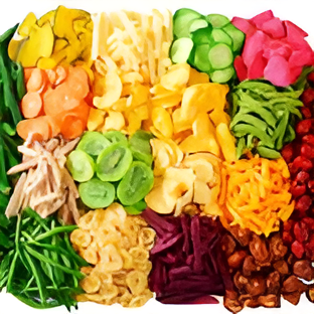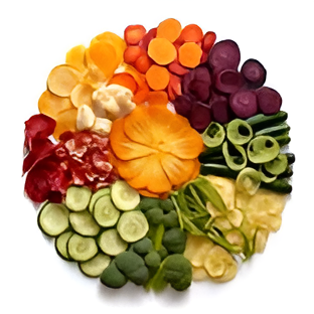Dehydrated Vegetables: A Comprehensive Guide

Dehydrated vegetables have become increasingly popular in recent years, not only for their convenience but also for their nutritional benefits and long shelf life. Whether you’re an outdoor enthusiast, a busy professional, or someone looking to incorporate more nutrients into your diet, dehydrated vegetables offer a versatile solution. In this guide, we will explore what dehydrated vegetables are, their benefits, the drying process, popular types, storage methods, and ways to incorporate them into your meals.
What Are Dehydrated Vegetables?
Dehydrated vegetables are fresh vegetables that have had their moisture content removed through various drying methods. This process preserves the vegetables and extends their shelf life while retaining most of their nutrients, flavor, and color. Dehydration can be done using different techniques, including sun drying, air drying, oven drying, and using food dehydrators.
Benefits of Dehydrated Vegetables
- Long Shelf Life: One of the most significant advantages of dehydrated vegetables is their extended shelf life. When stored properly in a cool, dark place, they can last for months or even years without spoiling.
- Nutritional Retention: Dehydrating vegetables helps preserve essential nutrients such as vitamins, minerals, and antioxidants. While some nutrients may be lost during the process, many remain intact, making dehydrated vegetables a healthy choice.
- Convenience: Dehydrated vegetables are lightweight and easy to store, making them ideal for camping, hiking, or busy lifestyles. They are also quick to prepare; often, they only require rehydration in water before use.
- Versatility: Dehydrated vegetables can be used in various dishes, including soups, stews, salads, and casseroles. They can also be blended into powders for use in smoothies or seasoning blends.
- Cost-Effective: Buying dehydrated vegetables can be more economical than purchasing fresh produce, especially if you consider the waste associated with fresh vegetables spoiling.
The Dehydration Process
The process of dehydrating vegetables involves several steps:
- Selection: Choose fresh, high-quality vegetables. Ensure they are free from blemishes, bruises, or signs of spoilage.
- Preparation: Wash the vegetables thoroughly and cut them into uniform pieces. This ensures even drying. Depending on the vegetable, you may also need to blanch them briefly to preserve color and texture.
- Drying: There are several methods to dehydrate vegetables:
- Sun Drying: This traditional method involves placing vegetables in direct sunlight. It’s suitable for dry climates but can take several days.
- Oven Drying: This method uses low heat (around 140°F or 60°C) in a conventional oven. It’s faster than sun drying but can consume more energy.
- Food Dehydrators: These appliances are designed specifically for drying foods. They provide consistent heat and airflow, leading to even drying.
- Air Drying: Some herbs and small vegetables can be air-dried by hanging them in a warm, dry area.
- Cooling: Once the vegetables are dried, allow them to cool completely. This step is crucial to prevent moisture buildup in storage.
- Storage: Store dehydrated vegetables in airtight containers, such as glass jars or vacuum-sealed bags, in a cool, dark place.
Popular Types of Dehydrated Vegetables
Many vegetables can be dehydrated, each offering unique flavors and textures. Some popular options include:
- Tomatoes: Sun-dried tomatoes are a favorite for their rich flavor. They can be rehydrated for sauces or salads.
- Bell Peppers: Dried bell peppers add color and sweetness to dishes.
- Carrots: Dehydrated carrots retain their sweetness and are excellent in soups and stews.
- Onions and Garlic: These staples can be dried and used as seasoning or in various recipes.
- Mushrooms: Dried mushrooms have a concentrated flavor and can enhance the umami profile of dishes.
- Spinach: Dehydrated spinach is a nutrient-dense addition to smoothies, soups, and sauces.
How to Rehydrate Dehydrated Vegetables
Rehydrating dehydrated vegetables is straightforward. Here are some general steps:
- Soak in Water: Place the dried vegetables in a bowl and cover them with warm water. Let them soak for 15 minutes to several hours, depending on the type of vegetable.
- Drain: After soaking, drain any excess water. Some vegetables may require a quick rinse to remove any remaining grit.
- Cooking: Add rehydrated vegetables directly to your recipes, adjusting cooking times as necessary since they may cook faster than fresh vegetables.

Incorporating Dehydrated Vegetables into Your Diet
Dehydrated vegetables can be easily integrated into various meals. Here are some ideas:
- Soups and Stews: Add dehydrated vegetables directly to soups or stews for extra flavor and nutrition. Just remember to adjust liquid levels to account for the added water from rehydrating.
- Casseroles: Incorporate dried vegetables into casseroles for a nutrient boost.
- Smoothies: Blend dried vegetables into smoothies for added fiber and nutrients.
- Snacks: Snack on dehydrated vegetables as they are or mix them into trail mixes for a healthy treat.
- Sauces and Dips: Rehydrate and blend dried vegetables into sauces or dips for added flavor.
Storage and Shelf Life
To maximize the shelf life of dehydrated vegetables, follow these storage tips:
- Use Airtight Containers: Ensure that containers are sealed tightly to prevent moisture and air from entering.
- Cool and Dark Storage: Store in a cool, dark place to avoid light exposure, which can degrade the quality.
- Check for Moisture: Regularly check stored vegetables for any signs of moisture or spoilage.
Conclusion
Dehydrated vegetables are an excellent addition to any kitchen, offering convenience, nutritional benefits, and versatility. With various methods of dehydration and a wide array of vegetables to choose from, they provide endless possibilities for enhancing your meals. Whether you’re preparing for an outdoor adventure or simply looking to save time in the kitchen, dehydrated vegetables are a practical and delicious solution. So go ahead, stock up on these nutritious powerhouses and elevate your cooking with ease!